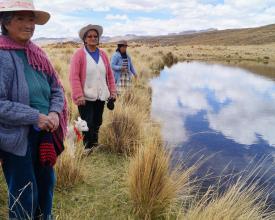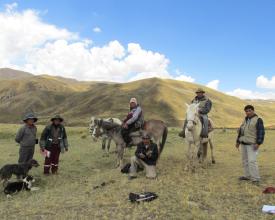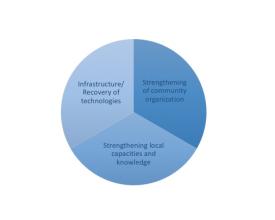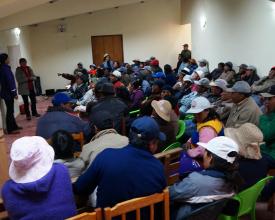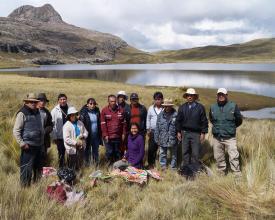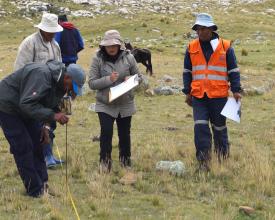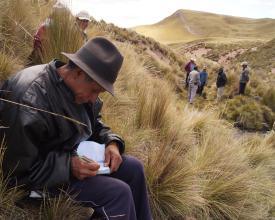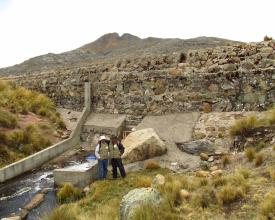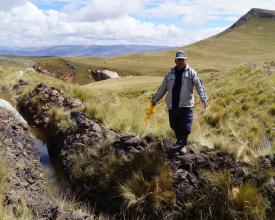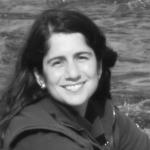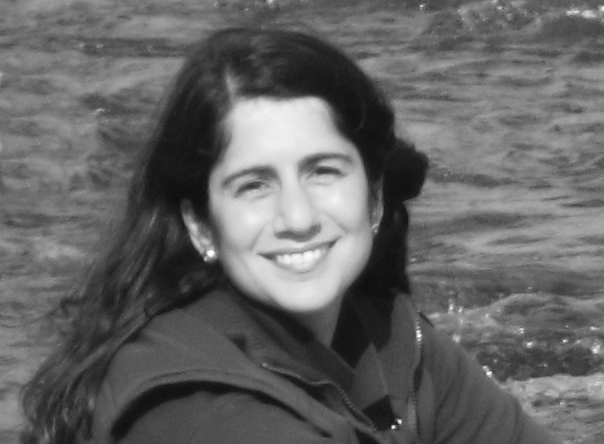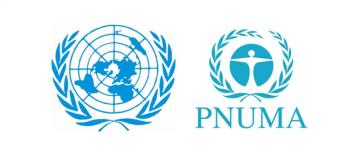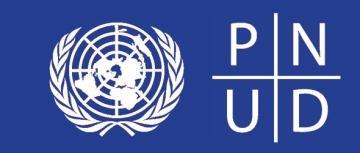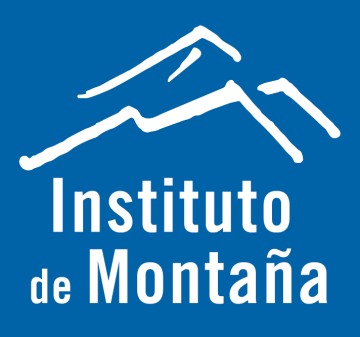
Restoring, conserving and expanding mountain pastures and wetlands and improving communal management in Canchayllo, Peru
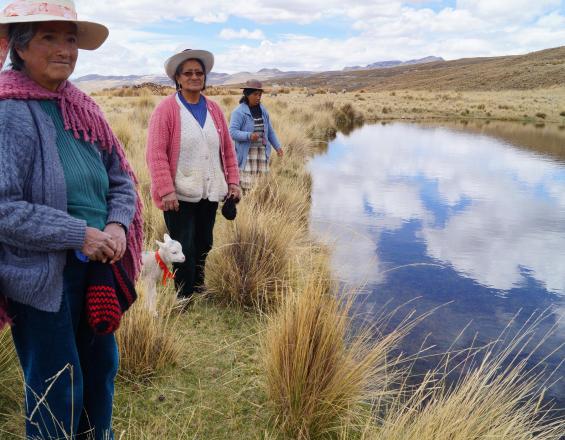
An Ecosystem based Adaptation measure was implemented by the community of Canchayllo and The Mountain Institute in partnership with the Nor Yauyos Cochas Landscape Reserve and IUCN. Our adaptation solution combined traditional (indigenous), local knowledge with the latest science and comprised three components: (1) Strengthening community organization, (2) Strengthening local capacities and (3) Combined green and grey infrastructure. Working together with scientists and practitioners, Canchayllo community members decided torepair awater dam and rehabilitate anold, unused water channel.
This led to the recovery of a network of ancient ditches in the communal farmland and surrounding areas that now supply water to 560 ha of pasture lands. In addition, the water is recharging temporary ponds and underground aquifers that supply water to pits and springs in the lower part of the Jaramayo micro-catchment and the Cochas - Pachacayo sub-basin.
Context
Challenges addressed
• Weak communal organization.
• Difficult access to the communal area and low level of local participation at the beginning.
• Initial mistrust towards the project.
• Only 41% of the population (mainly livestock farmers) reported to depend directly on ecosystem services (related to pasture and water).
• Difficulties in matching local expectations with the EbA approach due to conflicting interests within the community and among authorities (i.e. livestock farmers versus those who look for alternative income opportunities such as mining).
Location
Process
Summary of the process
The building blocks are articulated in a way that contributes to the initiative’s sustainability. The technology-based infrastructure combined with activities to strengthen technical and organizational capacities build the basis for the measure’s sustainable implementation and maintenance.
• Strengthening of community organization
• Strengthening local capacities and knowledge
• Infrastructure/ Recovery of technologies
Building Blocks
Strengthening of Community Organization
Under the component “Strengthening of Community Organization,” a management plan was developed to promote integrated management of pastures, water and livestock throughout the communal territory of Canchayllo. The goal was to strengthen community organization so that water could be distributed more effectively and grazing areas could benefit from improved rotation. The process to develop the management plan was facilitated by The Mountain Institute using a methodology to strengthen capacities, stimulating collective and social practices within the community. The plan is defined as a set of ideas that emerge from a given population by means of an in-depth process of analysis based on their own perspectives. The management plan can also serve as a tool for local management in the medium term.
According to the keen interest of this community, analysis and planning have focused on grasslands and water. The plan also encouraged the community to establish a committee to maintain and operate the renovated water infrastructure so that the water continues to flow and grasslands continue to be irrigated. In addition, a document with technical recommendations was developed for managing communal grasslands.
Enabling factors
• Local and scientific knowledge exchange: participation and exchange among both local and external experts.
• Participatory approach and participatory action-research methodology.
• Commitment on the part of communal partners.
• Sound relationship and coordinated work between The Mountain Institute and the Nor Yauyos-Cochas Landscape Reserve/ Peruvian Service of Natural Protected Areas (SERNANP).
• Communication as a central component.
• Farmers’ interest.
• Steady support through a facilitator.
Lesson learned
• A sound assessment of the social component is key in the diagnostic, including analyzing the current status but also past and present conflicts, as well as the tensions and tendencies. It’s also advisable to pay particular attention to existing activities incompatible with the EbA approach or other planned measures.
• Sufficient time is required to address the socio-economic, political and cultural dimensions in addition to the biophysical aspects (which often receive the most attention). Equally important are local governance, including mapping and analyzing past and present conflicts within the community, the direct dependence on ecosystem services and the type of management of the territory in the specific areas of the pre-selected measures.
• A good understanding of decision-making with regard to the management of resources in a specific area is key. This could be a community board, one or several families, an association within the community, etc.
Strengthening Local Skills and Knowledge
As part of the “Strengthening Local Skills and Knowledge” component, we conducted courses and workshops, facilitated discussion events, and led training on how to apply pasture recovery techniques and evaluate their effectiveness. These activities helped sensitize community farmers, inspiring them to create new, small projects such as fencing and recovery of pasturelands or water and livestock management. In addition, the monitoring system applied shows that skills for pasture management, with regard to evaluation, fencing and recovery at the family and community levels, have increased (IM, IUCN, 2015). As part of the communication activities, an informational showcase and two participatory videos, a theatre play and publications were produced. This contributed to raising awareness among the group of livestock farmers regarding pastures, water and livestock management and helped disseminate information about the project at community and landscape reserve levels (IM, IUCN, 2015). Information was generated through participatory rural diagnostics (specific studies in water, pasture, archaeology, social organization, productive activities) and a hydro-geological study in the water channel’s area of influence.
Enabling factors
• Use of communication tools to increase local awareness and understanding of the project.
• Dialogue and knowledge exchange between local and external experts.
• Communication as a central component.
• Steady support through a facilitator.
• Local researchers served as a bridge between the project and the whole community.
Lesson learned
• Plan communication activities as a cross-cutting issue of the project.
• Include activities that involve those groups within the community that may be underrepresented. For example, participatory videos, theatre plays and artistic activities are particularly suitable to convey messages to young people, women, children and elders.
• It is helpful to have a team trained in applying a participatory approach, using participatory tools and facilitating collective learning.
• Diversify methods with local partners, combining workshops with other, more practical and field-based ("learn-by-doing") methods and tools.
• Design and implement a communication strategy that helps to disseminate the intermediate achievements of the project. This might include communication tools of great appeal and impact, such as participatory videos and theatre plays or “Art Night".
• Maintain a high level of presence in the field and share everyday life with the community.
Recovery of Technologies & Green-Gray Infrastructure
In the “Recovery of Technologies & Green-Gray Infrastructure” component, the Chacara dam was repaired and an old and unused water channel was rehabilitated. This allowed the recuperation of a network of ancient ditches in the communal farmland and in the high areas of Yanaututo and Pumapanca. These areas supply water to 560 ha of pasturelands (Hidroandes, 2015). In addition, the water is recharging temporary ponds and underground aquifers, that supply water to pits and springs in the lower part of the Jaramayo micro-catchment and the Cochas - Pachacayo sub-basin (Idem, 2015). A pilot area of 3 ha was fenced to protect pastures as they recover. It is monitored by the Landscape Reserve administration with support from the community. The community also contributed manpower to the activities in this component.
Enabling factors
• Strong commitment from the community who contributed 45% of the cost through manpower, materials, equipment and machinery.
• Local researches linked the project with the communities.
• Commitment on the part of communal authorities.
• Sound relationship and coordinated work between the Mountain Institute and the Nor Yauyos-Cochas Landscape Reserve/ Peruvian Service of Natural Protected Areas (SERNANP).
• Steady support through a facilitator.
Lesson learned
• Demand-oriented: The selection of measures should respond to local priorities and interests (being consistent with the EbA approach).
• Take into account the percentage of the population directly benefitting from (certain) ecosystem services as a selection criterion.
• Plan sufficient time for infrastructure measures, especially in areas of rugged topography and extreme climate, typical of high mountain areas, and in particular when local manpower/communal work is an integral part. Make sure the time required for the construction is in line with the timeline of the project.
• Reserve time for reflection during the implementation phase in order to take actions that enhance positive impacts.
• Seek commitment and support from local authorities/ leaders and involve them in key decision-making processes. Build partnerships with local governments, which will help to make the initiative sustainable.
Impacts
The water storage capacity of the community area improved due to repairs made to the Chacara lake dam. In September 2015, a flow of 184 litres per second was recorded. With the rehabilitation of the main channel, Chacara-Jutupuquio (2,855 m), water availability in the upper part of the community increased. Wetland zones and troughs were formed and an ancestral water channel was recovered in the area under collective management. This restored channel—a combination of a PVC pipeline and infiltration ditches with water distribution and regulation functions—supplies water to 560 hectares of native pastures and grazing sectors.
The probability of fires was reduced due to higher humidity in the pastures. Bird sightings, such as ducks (Anas flavirostris), have increased. These can be spotted in the lagoons or temporary qochas (natural ponds), which are formed by the water that runs through the restored channel and system of ditches. Three hectares of native pastures have been recovered in a natural way through demonstration plots.
Beneficiaries
• Direct: 60 families related to livestock-farming in the rural community of Canchayllo.
• Indirect: 150 families (approx. 700 persons) in the community of Canchayllo and population living in the middle and lower part of the watershed.
Sustainable Development Goals
Story
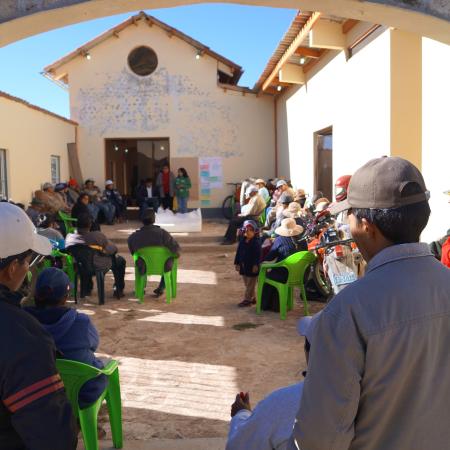
Testimonial of Gonzalo Quiroz - Head of the Nor Yauyos-Cochas Landscape Reserve
"Unlike other projects that come with a pre-established formula and say 'I have to do A, B, C, D and these are my indicators and my results', I think one of the benefits of this project may have been that it was possible to design it during the term. Unlike other projects that have everything encapsulated at the start, and say 'well I have to do this and I cannot even change the name of the activity'.
I think that has been one of the positive things about this project. [...] It is a matter of ownership, right? It has not been a parallel construction process or that one has developed it without the intervention of the other, I believe it has been a common planning process and this has been reflected in the master plan and in the activities that have been implemented.
We (Nor Yauyos-Cochas Landscape Reserve and The Mountain Institute) have aligned with each other and I do not think that was for a mandate, it has not been an order. It was because it was of mutual benefit, because we are two institutions that intervene in the same territory. The logic is that we have to support each other because in the end these activities are implemented for the benefit of the population, not of the institutions. [...]
Ideally, we form one single team and I think that has worked, because we made the calls and invitations in a common language. Both institutions signed one invitation letter and both your staff [The Mountain Institute] and ours [Nor Yauyos-Cochas Landscape Reserve] helped to ensure the call, participated in the workshops, participated in the activities ... So it hasn´t been a process of orders in the beginning and empowerment in the end, this process we have designed and carried forward together with a common goal. So as an institution, we are implementing this common goal.
If I'm going to work on the issue of ecosystem restauration to improve the water harvest, well, it will be a minimum of three years, four years to do the infrastructure, pasture management, sensitize people to implement that management and to see how that ecosystem or that ecosystem service that is part of the pasture, that is the fodder, begins to improve the quality of life of the people."

